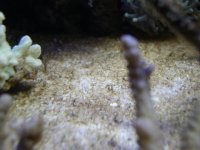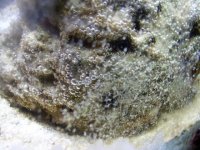I have had this infection of the dinoflagalates way too long and cant control them. I have done everything conventional to get rid of an algea problem but have had no success.
I have done large water changes, scrubbed all the dinos off the rocks and sand bed, cleaned the skimmer every couple of days, everything I could think of in the last couple of months but cant get rid of them.
I know that some people reccomend raising the PH to 8.4 for a few days but my Ph already rides high as all my top off is done through a nielson reactor.
I also read about leaving the lights off for a few days but this concerns me because this is a SPS/Clam tank and I dont want to cause any addtional stress to my corals or clams. I am very frustrated now and just hope some one has the answer.
TANK INFO:
75 gal AGA with 100lbs figi + 4" sand bed,30 gal sump, lifereef overflow
lighting: 2 x 400 watt 65k MH - 3 x 110 watt VHO actinics
Filtration: Euro-reef CS8-3 skimmer
I use a kent HI-S maxima with new membrane and all other filters for water change and all top off. I do a 25% water change bi weekly. The RO/DI unit keeps a bucket full and my liter meter dosing pump does all my top off through a my reef kalkreactor (nielson reactor).
I also dose 5 scoups of Tropic marins bio-calcium daily.
My bioload includes a CB butterfy, small clown, foxface and a female 3 stripe damsel. I also have 2 tigertail cukes. Tried poly filters once with no effect.
Some one PLEASE sovle my problem!!!
TIA
I have done large water changes, scrubbed all the dinos off the rocks and sand bed, cleaned the skimmer every couple of days, everything I could think of in the last couple of months but cant get rid of them.
I know that some people reccomend raising the PH to 8.4 for a few days but my Ph already rides high as all my top off is done through a nielson reactor.
I also read about leaving the lights off for a few days but this concerns me because this is a SPS/Clam tank and I dont want to cause any addtional stress to my corals or clams. I am very frustrated now and just hope some one has the answer.
TANK INFO:
75 gal AGA with 100lbs figi + 4" sand bed,30 gal sump, lifereef overflow
lighting: 2 x 400 watt 65k MH - 3 x 110 watt VHO actinics
Filtration: Euro-reef CS8-3 skimmer
I use a kent HI-S maxima with new membrane and all other filters for water change and all top off. I do a 25% water change bi weekly. The RO/DI unit keeps a bucket full and my liter meter dosing pump does all my top off through a my reef kalkreactor (nielson reactor).
I also dose 5 scoups of Tropic marins bio-calcium daily.
My bioload includes a CB butterfy, small clown, foxface and a female 3 stripe damsel. I also have 2 tigertail cukes. Tried poly filters once with no effect.
Some one PLEASE sovle my problem!!!
TIA







